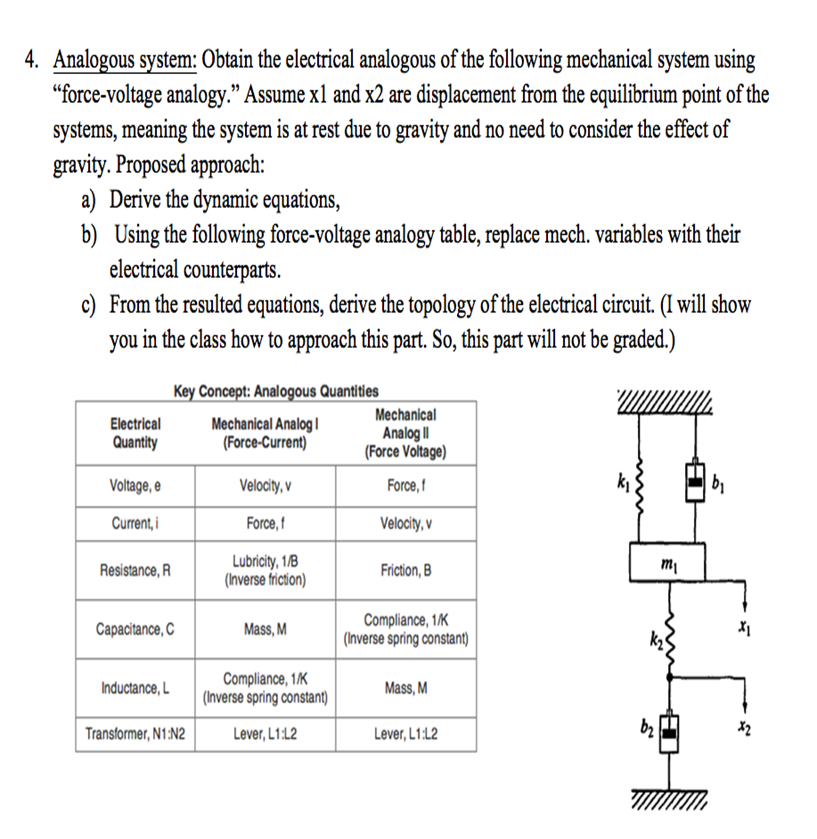Answered step by step
Verified Expert Solution
Question
1 Approved Answer
4. Analogous system: Obtain the electrical analogous of the following mechanical system using force-voltage analogy. Assume x1 and x2 are displacement from the equilibrium

4. Analogous system: Obtain the electrical analogous of the following mechanical system using "force-voltage analogy." Assume x1 and x2 are displacement from the equilibrium point of the systems, meaning the system is at rest due to gravity and no need to consider the effect of gravity. Proposed approach: a) Derive the dynamic equations, b) Using the following force-voltage analogy table, replace mech. variables with their electrical counterparts. c) From the resulted equations, derive the topology of the electrical circuit. (I will show you in the class how to approach this part. So, this part will not be graded.) Electrical Quantity Voltage, e Current, i Resistance, R Key Concept: Analogous Quantities Mechanical Analog I (Force-Current) Capacitance, C Inductance, L Transformer, N1:N2 Velocity, v Force, f Lubricity, 1/B (Inverse friction) Mass, M Compliance, 1/K (Inverse spring constant) Lever, L1:L2 Mechanical Analog II (Force Voltage) Force, f Velocity, v Friction, B Compliance, 1/K (Inverse spring constant) Mass, M Lever, L1:L2 5 m C X1 35 4. Analogous system: Obtain the electrical analogous of the following mechanical system using "force-voltage analogy." Assume x1 and x2 are displacement from the equilibrium point of the systems, meaning the system is at rest due to gravity and no need to consider the effect of gravity. Proposed approach: a) Derive the dynamic equations, b) Using the following force-voltage analogy table, replace mech. variables with their electrical counterparts. c) From the resulted equations, derive the topology of the electrical circuit (I will show you in the class how to approach this part. So, this part will not be graded.) Electrical Quantity Voltage, e Current, i Resistance, R Key Concept: Analogous Quantities Mechanical Analog I (Force-Current) Capacitance, C Inductance, L Transformer, N1:N2 Velocity, v Force, f Lubricity, 1/B (Inverse friction) Mass, M Compliance, 1/K (Inverse spring constant) Lever, L1:L2 Mechanical Analog II (Force Voltage) Force, f Velocity, v Friction, B Compliance, 1/K (Inverse spring constant) Mass, M Lever, L1:L2 5 m C X1 35 4. Analogous system: Obtain the electrical analogous of the following mechanical system using "force-voltage analogy." Assume x1 and x2 are displacement from the equilibrium point of the systems, meaning the system is at rest due to gravity and no need to consider the effect of gravity. Proposed approach: a) Derive the dynamic equations, b) Using the following force-voltage analogy table, replace mech. variables with their electrical counterparts. c) From the resulted equations, derive the topology of the electrical circuit. (I will show you in the class how to approach this part. So, this part will not be graded.) Electrical Quantity Voltage, e Current, i Resistance, R Key Concept: Analogous Quantities Mechanical Analog I (Force-Current) Capacitance, C Inductance, L Transformer, N1:N2 Velocity, v Force, f Lubricity, 1/B (Inverse friction) Mass, M Compliance, 1/K (Inverse spring constant) Lever, L1:L2 Mechanical Analog II (Force Voltage) Force, f Velocity, v Friction, B Compliance, 1/K (Inverse spring constant) Mass, M Lever, L1:L2 5 m C X1 35
Step by Step Solution
★★★★★
3.52 Rating (165 Votes )
There are 3 Steps involved in it
Step: 1
a To derive the dynamic equations for the mechanical system we need to analyze the forces acting on ...
Get Instant Access to Expert-Tailored Solutions
See step-by-step solutions with expert insights and AI powered tools for academic success
Step: 2

Step: 3

Ace Your Homework with AI
Get the answers you need in no time with our AI-driven, step-by-step assistance
Get Started


